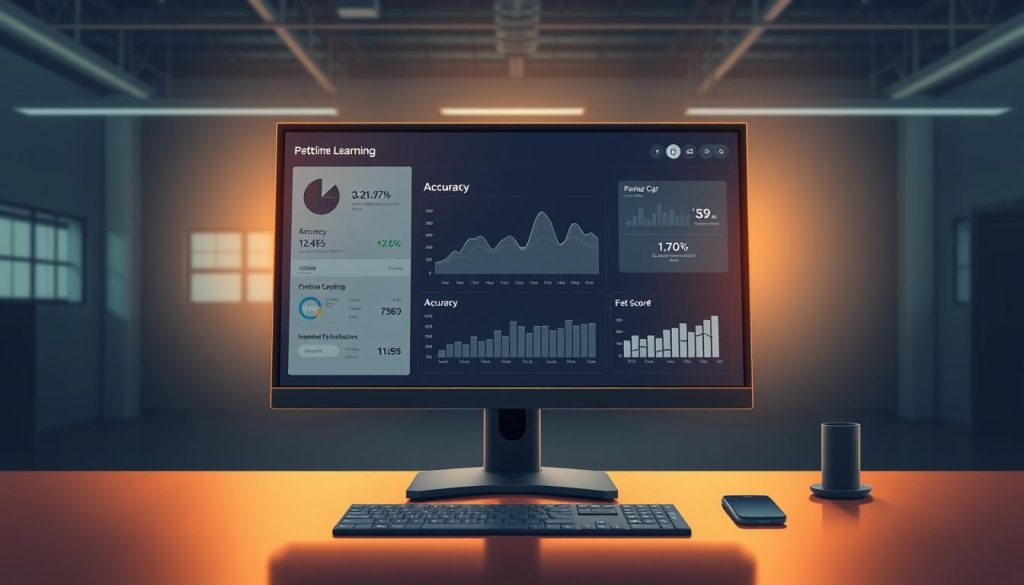What if your career success depended on numbers you’re not tracking? While many professionals focus on skills and experience, measurable indicators often determine long-term stability in today’s competitive landscape.
Organizations prioritizing these measurable indicators achieve 30% higher revenue growth than peers. For independent workers, they’re not just tools for evaluation – they’re proof of your value. Clear data transforms abstract contributions into undeniable evidence employers and clients trust.
This guide reveals how to identify and leverage the right indicators for your career. You’ll learn to align efforts with strategic goals, spot improvement areas early, and build credibility through transparency. Whether negotiating contracts or seeking promotions, these insights turn uncertainty into actionable plans.
Table of Contents
Key Takeaways
- Quantifiable data builds trust with stakeholders and strengthens professional relationships
- Regular self-assessment helps identify strengths and growth opportunities
- Strategic alignment of goals increases visibility for promotions or client retention
- Transparent reporting positions you as a reliable, results-driven expert
- Data-backed decisions reduce career risks while accelerating growth
Introduction to Professional Performance Metrics
Modern careers thrive on verifiable achievements rather than vague assumptions. While traditional markers like job titles still matter, decision-makers increasingly rely on concrete evidence to assess value. This shift demands new strategies for demonstrating expertise.
Defining Performance Metrics in Today’s World
Contemporary evaluation systems blend numbers and narratives. Consider these core components:
| Metric Type | Workplace Example | ML Equivalent |
|---|---|---|
| Quantitative | Revenue growth | Accuracy scores |
| Qualitative | Client testimonials | Model interpretability |
| Strategic | Market share gains | Training efficiency |
Unlike machine learning’s loss functions (which optimize models), professional measurements track real-world impact. However, both fields share a critical truth: what gets measured gets improved.
Relevance for Career and Business Stability
Independent workers particularly benefit from systematic tracking. A well-documented 15% efficiency gain often justifies higher rates better than years of experience. Three key advantages emerge:
- Client negotiations become fact-based discussions
- Skill gaps surface before they affect income
- Progress timelines validate pricing strategies
Regular documentation creates career safety nets. When projects evolve or markets shift, your recorded achievements provide stability through change.
Importance of Performance Metrics for Long-Term Career Growth

Career trajectories aren’t left to chance—they’re built on measurable evidence. Professionals who document their impact systematically gain strategic advantages in competitive markets. Studies reveal teams using data-driven career strategies achieve 23% faster advancement rates than peers relying solely on subjective evaluations.
Turning Data Into Career Currency
Three critical benefits emerge when tracking professional progress:
- Visibility in promotions: Documented achievements become bargaining chips during salary negotiations
- Risk mitigation: Spot skill gaps 6-8 months before they affect project outcomes
- Strategic positioning: Align personal milestones with organizational priorities
Consider this comparison of career development approaches:
| Traditional Methods | Metric-Driven Approach |
|---|---|
| Annual reviews | Quarterly progress dashboards |
| Subjective feedback | Client satisfaction scores |
| Generic resumes | Portfolios with outcome metrics |
Professionals using structured tracking systems report 40% higher client retention rates. As one HR director notes: « When we see concrete numbers behind someone’s work, it transforms how we allocate opportunities. »
This method creates natural accountability. By reviewing weekly progress indicators, you maintain momentum toward long-term objectives while adapting to market shifts. The result? Continuous growth that withstands economic fluctuations.
Exploring Performance Metrics: Techniques and Applications

Imagine building a bridge without checking if it can hold weight—that’s what working without data tracking feels like. Specialized measurement systems turn abstract skills into actionable insights across industries.
Measuring Performance in Machine Learning and Data Models
Technical fields use precise evaluation tools. For predicting numerical outcomes:
- MAE shows average prediction errors without exaggeration
- RMSE highlights larger discrepancies in results
- R² scores reveal how well models explain data patterns
In classification tasks, precision measures decision accuracy, while recall tracks completeness. The F1-score balances both—like ensuring a chef uses fresh ingredients (precision) without wasting food (recall).
Real-World Business and Employee Examples
Top companies tie individual contributions to organizational results:
| Company | Revenue/Employee | Key Driver |
|---|---|---|
| Netflix | $2.49M | Content personalization systems |
| Apple | $2.35M | Product development efficiency |
Software teams track deployment frequency alongside code clarity scores. Customer service roles monitor resolution times and satisfaction rates. One support specialist shared: « When I reduced average call time by 18%, client renewals jumped 23%. »
These approaches create clear improvement roadmaps. Whether optimizing code or client interactions, measurable indicators turn effort into career capital.
Tools and Methods for Measuring Success
Professionals now have unprecedented power to track their impact through intelligent systems. The right combination of technology and methodology transforms raw information into career-advancing insights.
Data-Driven Approaches and Cutting-Edge Tools
Modern tracking solutions range from simple spreadsheets to AI-powered platforms. Customer Relationship Management (CRM) systems automatically log interactions, response times, and satisfaction trends. For technical roles, Python libraries like NumPy handle calculations for error rates and prediction accuracy.
| Basic Tools | Advanced Systems | Best For |
|---|---|---|
| Spreadsheets | neptune.ai | Individual tracking |
| Python scripts | Cloud dashboards | Team collaborations |
| Call logs | CRM integrations | Client-facing roles |
Contact centers demonstrate the power of specialized measurement. One support team leader shared: « When we linked first-call resolution rates to client retention, our training focus shifted overnight. » Their tools tracked handling times and service levels, revealing hidden patterns in customer interactions.
Three principles guide effective implementation:
- Start simple: Basic programming or spreadsheet skills can build custom trackers
- Prioritize integration: Connect client management systems with competitive analysis platforms
- Focus on trends: Weekly progress snapshots beat annual reviews
Cloud-based dashboards now offer real-time updates across devices. This immediacy helps professionals adjust strategies before minor issues become career obstacles. As tools evolve, they create clearer paths between daily efforts and long-term goals.
Enhancing Employee Outcomes: Quality, Quantity, and Efficiency Metrics
How do top professionals maintain excellence while delivering consistent results? The answer lies in balancing three pillars: quality standards, output volume, and resource optimization. These interconnected elements form a framework for sustainable career growth in competitive markets.
Assessing Work Quality and Efficiency in the Workplace
Quality measurement goes beyond error counts. Systems like 360-degree feedback evaluate leadership potential and teamwork skills. A software developer might track defects per thousand code lines, while consultants use client satisfaction scores (CSAT) to gauge service impact.
Efficiency analysis reveals hidden productivity gaps. Consider these comparisons:
| Traditional Approach | Metric-Driven Method |
|---|---|
| Annual performance reviews | Weekly progress dashboards |
| « Busy work » assumptions | Time-per-task measurements |
| Subjective workload estimates | CRM-tracked client interactions |
Case Studies on Employee Performance Evaluations
A Paris-based tech firm reduced coding errors by 42% using defect analysis paired with skill-building workshops. Their Net Promoter Score (NPS) simultaneously jumped 31 points within six months.
Another example: A Lyon sales team combined call metrics with customer feedback. By focusing on high-value interactions, they increased conversions 28% while working 12% fewer hours. « Tracking both activity and outcomes transformed how we approach client relationships, » their team lead noted.
Three actionable insights emerge:
- Regular skill assessments prevent minor gaps from becoming career obstacles
- Balanced tracking systems help negotiate better contracts or promotions
- Client-facing metrics build trust through transparent results
Leveraging Metrics for Continuous Improvement and Business Growth
Your career journey thrives on intentional refinement, not chance. Like a skilled navigator adjusting sails to changing winds, professionals who master measurement systems steer toward stability. This final approach transforms raw data into career-guiding constellations.
Three-Step Framework for Sustainable Success
Effective tracking begins with alignment. Connect personal milestones to organizational targets using shared indicators. A marketing consultant might tie campaign results to client revenue growth, while developers align code efficiency with product launch timelines.
Next, implement operational excellence strategies through regular checkpoints. Monthly reviews of client satisfaction scores or project completion rates create natural improvement cycles. One graphic designer increased repeat contracts by 34% after tracking design iteration counts against approval timelines.
Finally, use insights to anticipate challenges. Analyzing quarterly productivity patterns helps independent workers adjust workloads before burnout occurs. This proactive stance builds resilience in fluctuating markets while demonstrating strategic foresight to clients.
By transforming numbers into actionable roadmaps, you create self-sustaining growth engines. The result? A career that evolves with market demands while maintaining core stability through measurable value creation.
FAQ
How do data-driven measurements improve career stability?
Tracking indicators like project completion rates or client satisfaction scores helps identify strengths and growth areas. This clarity lets professionals adapt strategically, ensuring consistent value delivery in evolving markets.
What tools help track work efficiency effectively?
Platforms like Google Analytics for digital output, HubSpot for sales pipelines, and Toggl for time management provide actionable insights. These tools quantify progress, helping align daily tasks with long-term goals.
Can KPIs apply to non-technical roles?
Absolutely. For example, customer service roles use resolution times and feedback ratings, while creatives measure campaign engagement or revision cycles. Tailored metrics ensure relevance across industries.
Why prioritize quality over quantity in evaluations?
High-quality outputs reduce errors and build trust, which sustains client relationships. Metrics like defect rates or peer reviews highlight excellence more accurately than sheer volume alone.
How do machine learning models use success benchmarks?
Algorithms rely on precision, recall, and F1 scores to validate accuracy. For instance, TensorFlow tracks model performance, ensuring reliable predictions that drive data-informed business decisions.
What’s a practical method to set measurable goals?
The SMART framework (Specific, Measurable, Achievable, Relevant, Time-bound) structures objectives. Pairing this with tools like Asana or Monday.com creates transparent progress tracking for teams and solo professionals.





